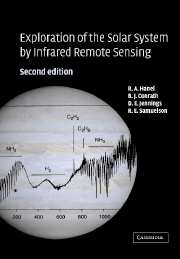Book contents
- Frontmatter
- Contents
- Introduction to first edition
- Introduction to second edition
- 1 Foundation of radiation theory
- 2 Radiative transfer
- 3 Interaction of radiation with matter
- 4 The emerging radiation field
- 5 Instruments to measure the radiation field
- 6 Measured radiation from planetary objects up to Neptune
- 7 Trans-Neptunian objects and asteroids
- 8 Retrieval of physical parameters from measurements
- 9 Interpretation of results
- Closing remarks
- Appendices
- References
- Abbreviations
- Index
1 - Foundation of radiation theory
Published online by Cambridge University Press: 07 September 2009
- Frontmatter
- Contents
- Introduction to first edition
- Introduction to second edition
- 1 Foundation of radiation theory
- 2 Radiative transfer
- 3 Interaction of radiation with matter
- 4 The emerging radiation field
- 5 Instruments to measure the radiation field
- 6 Measured radiation from planetary objects up to Neptune
- 7 Trans-Neptunian objects and asteroids
- 8 Retrieval of physical parameters from measurements
- 9 Interpretation of results
- Closing remarks
- Appendices
- References
- Abbreviations
- Index
Summary
In this chapter we review the physical foundation of remote sensing. Except for possible gravitational effects, information accessible to a distant observer must be sensed as electromagnetic radiation, either in the form of reflected or refracted solar or stellar radiation, or in the form of thermal or nonthermal emission. We restrict the discussion to passive techniques. Active methods, involving the generation of electromagnetic radiation (radar, lidar), are not explicitly treated. However, the physical principles discussed in this text are equally applicable to passive and active methods. In either case a discussion of the measurement and interpretation of remotely sensed data must be based on electromagnetic theory. In Section 1.1 we begin with that theory by reviewing Maxwell's equations. The application of the principle of energy conservation to Maxwell's equations leads to the Poynting theorem with the Poynting vector describing radiative energy transport; this is discussed in Section 1.2. However, the Poynting vector does not characterize more complex phenomena, such as reflection, refraction, polarization, or interference; all of these phenomena play significant roles in many aspects of remote sensing. Their study requires, first, a derivation of the wave equation from Maxwell's formulas, and second, finding appropriate solutions for the electric and magnetic field vectors; this is the subject of Section 1.3. Polarization is briefly reviewed in Section 1.4. Effects of electromagnetic waves striking an interface between two media and the conditions that must be satisfied at the boundary are treated in Section 1.5.
- Type
- Chapter
- Information
- Publisher: Cambridge University PressPrint publication year: 2003



